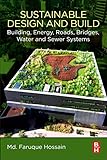Sustainable design and build [electronic resource] : building, energy, roads, bridges, water and sewer systems / Faruque Hossain.
Material type: TextPublication details: Oxford : Butterworth-Heinemann, an imprint of Elsevier, 2019.Description: 1 online resource (464 p.)ISBN:
TextPublication details: Oxford : Butterworth-Heinemann, an imprint of Elsevier, 2019.Description: 1 online resource (464 p.)ISBN: - 9780128168882
- 0128168889
- 720.47
- TH880
| Item type | Current library | Shelving location | Call number | Status | Date due | Barcode | Item holds | |
|---|---|---|---|---|---|---|---|---|
 Electronic Book
Electronic Book
|
Kuakarun Nursing Library | Processing unit | Online Access | Eb33743 |
Description based upon print version of record.
Front Cover; SUSTAINABLE DESIGN AND BUILD; SUSTAINABLE DESIGN AND BUILD: Building, Energy, Roads, Bridges, Water and Sewer Systems; Copyright; DEDICATION; CONTENTS; ABOUT THE AUTHOR; PREFACE; One -- Introduction; 1.1 ENVIRONMENT; 1.2 ENERGY; 1.3 BUILDING; 1.4 INFRASTRUCTURE AND TRANSPORTATION; 1.5 WATER; 1.6 CONCLUSION; ACKNOWLEDGMENTS; REFERENCES; Two -- Environment; 2.1 AIR; 2.1.1 Background; 2.1.2 Methods and Approach; 2.1.2.1 CO2 Emissions From Fossil Fuel; 2.1.2.2 CO2 Emissions From the Land-Use Change (ELUC); 2.1.2.3 Ocean CO2 Sink
2.1.2.4 CO2 Absorption by Terrestrial Vegetation and the Earth2.1.2.5 Calculation of the Growth Rate of the Atmospheric CO2 Concentration (GATM); 2.1.3 Results and Discussion; 2.1.3.1 CO2 Emissions From Fossil Fuels, Land-Use Change, and Other Factors; 2.1.3.2 Ocean and Terrestrial Vegetation CO2 Sinks; 2.1.3.3 Cumulative CO2 Emissions and Atmospheric Impact; 2.1.4 Conclusion; 2.2 WATER; 2.2.1 Introduction; 2.2.2 Current Knowledge of Emerging Contaminant Occurrence in Wastewaters and Surface Waters; 2.2.3 Factors Which Influence Receiving Wastewater Concentration; 2.2.4 Spatial Distribution
2.2.5 Intraday Variation2.2.6 Interday Variability; 2.2.7 Partitioning of Emerging Contaminants to Solid Matter during Wastewater Treatment; 2.2.8 River Sediments and Amended Soils; 2.2.9 Diagnosis of Emerging Contaminant Removal During Wastewater Treatment; 2.2.10 Conclusions; 2.3 LAND; 2.3.1 Background and Introduction; 2.3.2 Root Cause Analysis for Land-Use Change; 2.3.3 Spatial Processes and Spatial Pattern Identification; 2.3.4 Intensification; 2.3.5 Critical Processes Affecting Land Use and Land Management; 2.3.6 National Policies; 2.3.7 Civil Strife and Insecurity
2.3.8 Income Diversification and Urbanization2.3.9 Environmental Change Impact; 2.4 DISCUSSION; 2.5 CONCLUSION; 2.6 CLIMATE CHANGE; 2.6.1 Introduction; 2.6.2 Climatic Forces; 2.6.3 Internal Forcing Mechanisms; 2.6.4 Thermohaline Circulation; 2.6.5 Effects on Global Climate; 2.6.6 External Climate Forcing; 2.6.7 Solar Output; 2.6.8 The Great Oxygenation Event; 2.6.9 Volcanism; 2.6.10 Climate Change Evidence; 2.6.11 Temperature Measurements and Proxies; 2.6.12 Glaciers; 2.6.13 Arctic Sea Ice Loss; 2.6.14 Vegetation; 2.6.15 Forest Genetic Resources; 2.6.16 Cloud Cover and Precipitation
2.6.17 Sea Level Change2.7 CONCLUSION; ACKNOWLEDGMENTS; REFERENCES; Three -- Energy; 3.1 CONVENTIONAL ENERGY; 3.1.1 Wood; 3.1.1.1 Energy Science; 3.1.1.2 Environmental Impact; 3.1.1.3 Human Health; 3.1.1.4 Climate Change; 3.1.2 Coal; 3.1.2.1 Formation; 3.1.2.2 Energy Science; 3.1.2.3 Production Engineering; 3.1.2.4 Surface Mining; 3.1.2.5 Strip Mining; 3.1.2.6 Contour Mining; 3.1.2.7 Underground Mining; 3.1.2.8 Environmental Impact; 3.1.2.9 Land and Surroundings; 3.1.2.10 GroundWater; 3.1.2.11 Surface Water; 3.1.2.12 Wildlife; 3.1.2.13 Food Chain; 3.1.2.14 Radiation Introduction
3.1.3 Petroleum
Master record variable field(s) change: 050, 650
There are no comments on this title.

